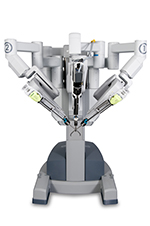 If you need a hysterectomy, you'll have access to our highly skilled surgeons. You may also have the option of having your surgery done using the latest in robotic surgical technology.
If you need a hysterectomy, you'll have access to our highly skilled surgeons. You may also have the option of having your surgery done using the latest in robotic surgical technology.
Hysterectomy is surgery to remove the uterus and sometimes the ovaries and fallopian tubes. For women, it is one of the most common operations in the U.S.
Many conditions can trigger a need for a hysterectomy, such as:
• Fibroids, benign growths in the uterus that can cause troublesome symptoms.
• Abnormal menstrual bleeding.
• Uterine prolapse, a condition in which the uterus slips down into the vagina.
• Endometriosis, a condition in which uterine tissue grows outside the uterus.
• Cancer or precancer of the uterus, ovaries, cervix or lining of the uterus.
There are several different ways to perform a hysterectomy:
• Through an open incision. A large cut is made in the abdomen, and the uterus is removed through this incision.
• With a laparoscope. Small cuts are made in the abdomen or vagina. A lighted tube and small surgical tools are then used to do the surgery.
• Through a small cut in the vagina.
• With the aid of a surgical robot.
Robotic surgery also is done through small cuts in the abdomen. The surgeon guides a robot from a nearby computer console. The robot's arms hold the small instruments and a 3-D camera. These surgical tools are put into the incisions to remove the uterus and, if needed, the ovaries and fallopian tubes.
Because it is done through small cuts, a robotic hysterectomy is less invasive than open surgery.
The camera also gives the surgeon an improved view of the surgical area. And the surgeon can move the robot's arms with high precision.
As a result, you may have:
• Less blood loss.
• A shorter hospital stay.
• Smaller scars.
• A quick recovery. Full recovery from robotic hysterectomy can take three to four weeks, which is often a shorter timeframe than with other types of surgery.
As always, discuss with your doctor your options for a hysterectomy so that you can choose the right surgery for you.
Watson Clinic gynecologic oncologist Richard J. Cardosi, MD, was the first physician in Polk County to successfully complete a hysterectomy procedure utilizing robotics. Obstetrician-gynecologists Samantha Curtis, MD, Tarek Garas, MD, and J. Brian Hopper, MD perform hysterectomies and a variety of other gynecologic procedures using the robotic method as well, including those aimed at treating reproductive issues, pelvic floor dysfunction and uterine fibroids. Meanwhile, general surgeon Thomas Moskal, MD was the first specialist in Lakeland to perform gallbladder removal procedures utilizing only a single 1-inch incision.
These Watson Clinic physicians perform their surgical procedures using the da Vinci Xi® equipment at either Lakeland Regional Health Medical Center or Bartow Regional Medical Center. For more information on these procedures, or to refer a patient to one of these specialists, call 863-680-7486 for general surgery, 863-680-7578 for gynecologic oncology, or 863-680-7243 for obstetrics-gynecology.
Sources: American Cancer Society; U.S. Department of Health and Human Services